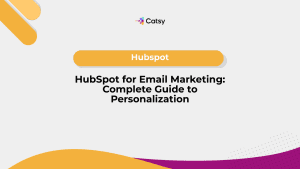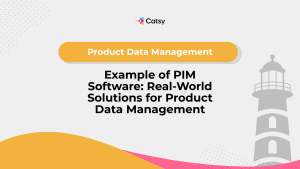4 Ways Catsy’s PIM & DAM Tools Will Help You Create Consistent Customer Experiences

- PIM & DAM tools empower users to create consistent customer experiences across channels.
- Marketing professionals can use PIM & DAM tools to keep up with product content demands across eCommerce channels and product catalogs.
- PIM & DAM tools in a single source of truth platform allow marketers to speed products to market effectively & consistently.
In this Article
The product information management and digital asset management tandem
Leveraging software tools such as a product information management system (PIM) and a digital asset management system (DAM) is essential to the growth and scalability of an eCommerce company.
If you’re new to eCommerce, you may wonder: what are PIM and DAM tools?
PIM and DAM tools can be used separately, and not every PIM includes a built-in DAM, such as Catsy’s all-in-one system.
PIM and DAM software provide enterprises with a single source of truth for all product digital assets and information.
This information includes everything you would find on a PDP: product images, videos, media, detail text files, guides and manuals, and other relevant content.
A PIM and DAM integrated system is a single solution for aggregating, organizing, categorizing, verifying, validating, enriching, and distributing product information and digital assets.
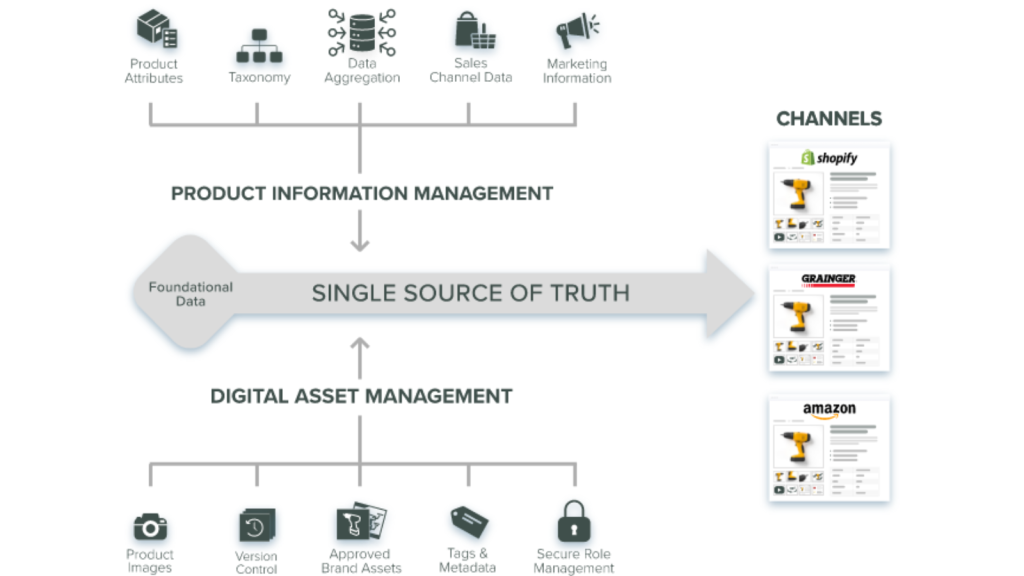
PIM/DAM Tools: The Dynamic Duo for eCommerce Channels
Creating a consistent customer experience across all online eCommerce channels of an enterprise requires a seamless and efficient aggregation and distribution of product information and digital assets, which make up the contents of a product details page (PDP).
In other words, product information and digital assets for multiple items need to be distributed in channel-specific templates for all channels a business sells on.
Arranging and distributing this content manually is a doable but daunting task due to the sheer magnitude of the information and the significant increase in the chance of human error.
Inconsistencies and inaccuracies in information and digital assets are one of the significant downfalls of eCommerce marketing. Not only can inaccuracies reflect poorly on the credibility and quality of the brand, but they can result in high return rates, costing the brand revenue.
Channel consistency with PIM/DAM tools
PIM and DAM include channel readiness scores and export templates, allowing marketers to quickly tailor content to channel requirements and export in channel format.
By automating a massive part of the process, brands can publish more item on the online market with confidence that content quality is consistent across the board.
As one of the market’s leading product information management solution providers, Catsy offers a single source of truth solution that helps organizations create and sustain consistent customer experiences across all channels and touchpoints online.
Let’s look at four ways Catsy’s PIM and DAM solution will help your organization maintain its success by creating consistent customer experiences:
1. Access to accurate, up-to-date, and rich product information
2. Leverage Omnichannel Means
3. Centralized marketing assets for sales reps
4. Launch faster
1. Access to accurate, up-to-date, and rich product information
a) Accurate Information
Catsy’s PIM and DAM tools offer a single APPROVED source of truth for product information and digital assets of all the items belonging to an organization.
Catsy PIM Software has security features that allow the organization to restrict the view, add, and edit access to specific personnel within and outside the organization.
Why is this important? Brands tend to allow view and export access to all personnel in the organization. This means that any technical product content authored by the engineering team or images taken by the marketing team can be viewed by all the members of an organization. For confidential information and assets, view and export access can be restricted to the department responsible for the content.
On the other hand, add and edit access is almost always restricted to the department or team that creates the content. This implies that only the engineering and R&D department can edit or add to item specification sheets, installation guides, repair guides, and other technical guides and manuals. Edit and view access is flexible and can be modified by the product management staff in the organization at any given time.
Approved Content in PIM/DAM
These features of the PIM and DAM system preserve content’s confidentiality, integrity, accuracy, and credibility. This system allows product content to be edited, updated, and written only by the most competent department.
This refers to the department that initially authored the content and is in charge of any updates to the content. Using the security features with Catsy’s PIM and DAM tools ensure that all information contained within this system is approved, as it has only been edited by the department or departments that have authored the content.
These approved digital assets and information can then be directly applied to channel templates, and after the completion of the template, content is distributed to appropriate eCommerce channels.
The line from the approved source of information and assets to the destination on details pages is direct, secure, and consistent. As an authorized source, Catsy’s PIM and DAM tools empower organizations to distribute consistently accurate information to all channels.
b) Up-to-date information
Similar to the approved process of authoring product information and digital assets, updating and editing content within the PIM and DAM system is a secure and seamless process. The authorized department makes updates and edits, and these edits can be immediately reflected on destination sites.
Catsy’s PIM and DAM solution comes with out-of-box workflow templates, enabling marketing teams to work together to speed products to market. Workflow tools are helpful whether a company is fully in-office, hybrid, or remote.
Brands can fully customize these automated workflows according to team needs and constraints. Using workflows, updates, and changes to information and assets can be conveyed with minimal delay, enabling content to stay up to date faster.
Up-to-date information and digital assets portray and highlight the product’s most recent features and attributes, which improves engagement and drives sales on details pages.
c) Rich content
From the moment product information and digital assets are imported from enterprise resource planning systems and other sources into the PIM and DAM system, content can be iteratively enriched, verified, and validated through various features offered by this solution. Here are some of the features that can be used to improve product content:
- Import mapping
- Channel content grading
- Product validation
- Completeness scores
- Readiness reporting
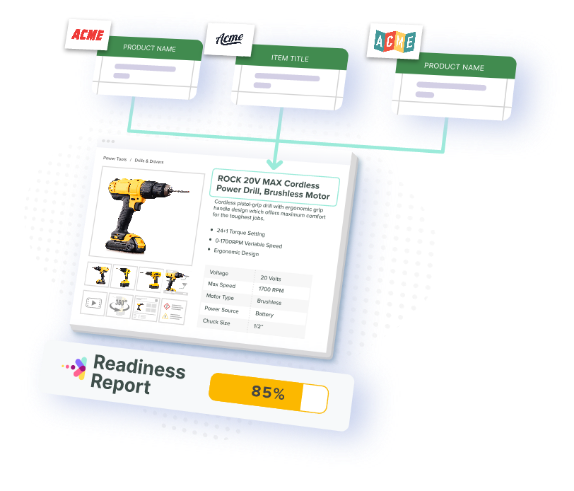
Import Mapping
Importing data from external sources allows enterprises to view and aggregate all content into a single repository. Still, what happens when product information imported is listed under different naming conventions?
Categorizing products and attributes (an essential part of ensuring discoverability across eCommerce channels) becomes impossible when multiple naming conventions exist for different items.
Using import mapping, enterprises can utilize the import mapping wizard to map items to consistent naming conventions. For example, if an item name is listed in an excel sheet under “product title,” the import mapping tool will map the product to the new naming convention and override the old name.
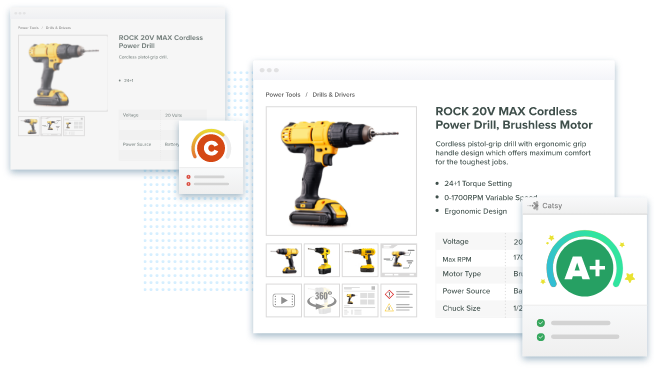
Channel Content Grading
Each channel that the enterprise distributes content requires this information and assets to be presented in a specific format because each distributor or retail site has a details page format.
Distributing content across different channels in different formats can prove to be quite confusing but using the product validation tool in Catsy’s PIM and DAM system, brands can arrange content into ‘channel templates’ before sending out content to a specific channel. Channel templates are templates of details pages of any particular retail or distributor site.
For each channel, PDPs tend to be similar for all products on their site, so brands can create templates of content within their PIM and DAM system to preview the page before it is sent to the site.
This tool allows brands to ensure that product content is arranged by a distributor or retail specifications, thereby increasing the speed of products to market. Performing this validation beforehand reduces the processing and validation needed on the destination site before the items can be published.
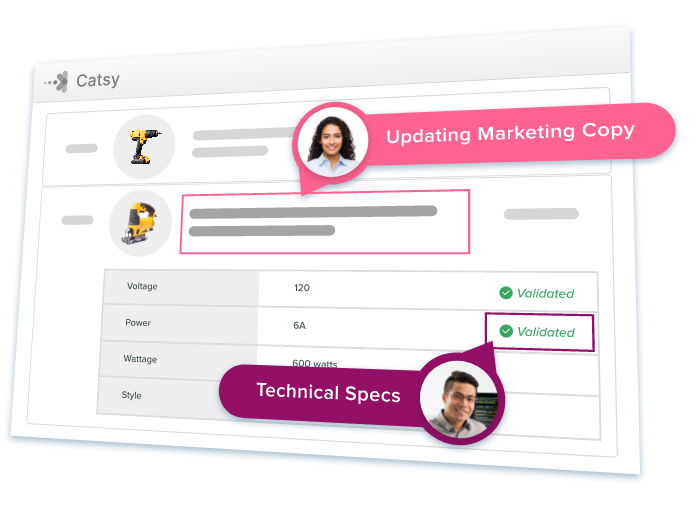
Product Validation
Mistakes can happen when product content is imported or manually entered into the PIM and DAM system.
For example, if a product engineer is entering the weight specification for an item into a system, they may accidentally type 5000 g instead of 50 g. If a mistake like this makes it to an eCommerce channel, customers may be deterred from purchasing an item with a specification that doesn’t make much sense.
Catsy allows custom validation rules to prevent mistakes like this from going live. If a product specification or attribute is entirely out of line or doesn’t make sense, it will be flagged, and users will be asked to address the issue before publishing the item.

Completeness scores
Similar to the functioning of the product channel grading tool, completeness scoring measures the completeness of product information. Rather than basing the score on channel requirements, however, the completeness score is customizable according to brand standards.
This tool gives brands more control over the appearance and organization of their content on product details pages. After meeting basic specifications set by the destination retail or distributor site, the brand can select additional criteria to enhance detail pages to increase engagement.
For example, a retail site may specify basic requirements for their product detail pages such as a description, technical information, pricing details, and a few digital assets such as primary and secondary images.
In addition, brands may choose to enhance the content on these pages by adding additional specifications such as three sixty spin photos, videos, manual preview, and lifestyle images.
Additional specifications set by the organization ensure that all content is consistent on every channel, regardless of channel requirements. This feature empowers the item to stand out against others on the same retail or distributor platform.
Using Catsy’s grading tools, an efficient approach can ensure that all items are represented with the same standard throughout the organization.
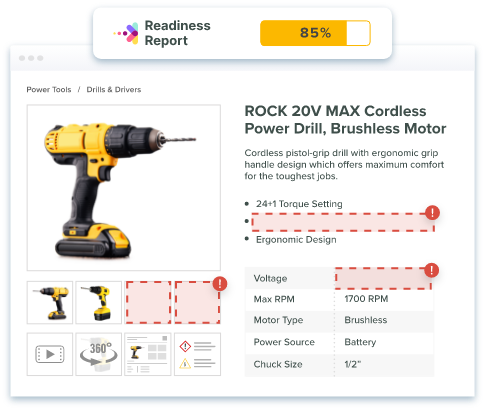
Readiness reporting
Readiness reporting is a comprehensive tool that measures product readiness for the market and provides recommended actions for items that are lacking content (as graded by the tools already mentioned.
This includes product information such as descriptions, specifications, pricing information, and age requirements, and digital assets such as primary and secondary photos, three sixty spin photos, lifestyle images, and videos.
This feature ensures that each item within this system has a complete and accurate profile, where the organization itself determines the criterion for completion.
It is essentially a process of self-verifying all the PIM and DAM repository content. Organizations can significantly reduce errors using readiness reporting as the content is passed down to distributors and other retail channels.
Using the features and tools mentioned above, brands can design grading tools that empower their departments to set specifications to drive engagement on product details pages. In addition to custom grading tools, Catsy offers recommended action tools that suggest areas of information that must be fixed continuously for fast optimization.
In addition, comprehensive readiness reports for each channel can be created based on the primary channel specifications and the organization’s additional specifications.
These reports can be used to verify the actual ‘completeness’ of the item before it can be published on retail and distributor channels.
Using these reports, Catsy makes it easy to use these grading tools to apply the exact specifications across all channels connected to the brand. This ensures that the quality and representation of all information and digital assets on product details pages remain consistent.
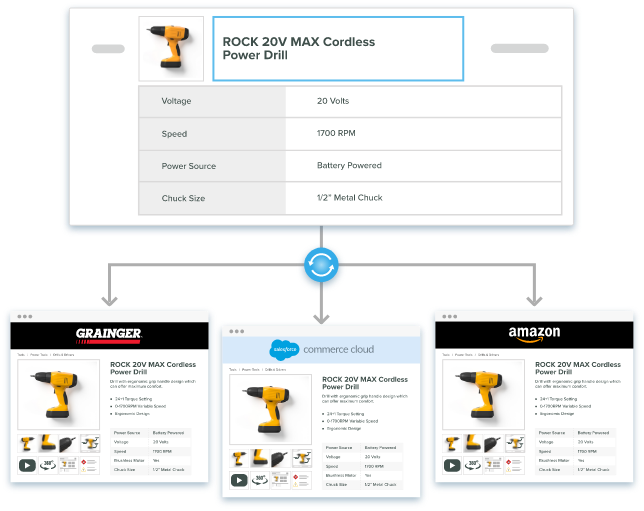
2. Leverage Omnichannel Means
Today’s most successful brands with an online presence operate through an omnichannel approach. Product information and digital assets are shared across multiple channels and touchpoints to create a coherent, engaging, and seamless online shopping experience for customers.
Simply put, customers can shop through various devices such as their phones, laptops, social media, and the in-person store.
Their activity on these different touch points is recorded and shared with all other touchpoints, which means that information received from the user when using their phone will be sent to the other touch points. Using an omnichannel approach, customers can pick up exactly where they are left off, even when they switch devices.
This creates a seamless user experience and drives engagement and revenue. With Catsy’s PIM and DAM system, brands have access to a single source of truth that can share product information and digital assets across all touchpoints and channels that the brand interacts. This system empowers the collaboration of multiple touch points to create various opportunities for the customers to interact with their product details pages.
For example, a customer is looking to buy a new water pump and adds a pump to the cart while shopping on their laptop. On the way back, they access the item from the coach on their phone to look at some of the product specifications and watch some videos before making a final purchase. The following day, the customer places the order on the website from his office desktop, and the pump reaches the desired location in the same week.
The PIM and DAM repository facilitates the exchange of product information and assets across these various touchpoints to ensure that all sites have the most up-to-date customer profiles possible.
When product profiles and details pages are ready to be published, Catsy’s PIM omnichannel publishing tools can be used to manage multiple stores, and products can be published across all distributors, retailers, and eCommerce store channels with just a few clicks.

3. Centralized marketing assets for sales reps
Catsy’s product information and digital asset management solution is a centralized repository for all information and digital assets for every item in the organization. The word ‘centralized’ refers to the feature allowing all authorized personnel and teams within the organization to view and export content.
With the power of a single centralized source of truth, organizations can drive collaboration between marketing teams and all other teams and save time that goes into manually sharing files through slow and outdated methods.
Any information or digital assets authored by engineering, logistics, HR, business analytics, and other teams in the organization can be viewed and exported by the marketing and sales teams to create and design details pages, sell sheets, brochures, advertisements, and other marketing documents.
Marketing teams can access any information and assets they need from the PIM-DAM system and use this system as a self-serve brand portal. Since the accuracy and consistency of the product’s content comes first, information and assets are authored by the most competent source, after which this accurate content can be accessed by the marketing team from the PIM and DAM integrated system.
This collaboration between the organization’s and marketing departments makes way for centralizing all marketing assets within the PIM and DAM system. To summarize, with this solution, organizations can unify their process by implementing an organization-wide visibility network, seamless sharing of assets and information, ensuring the security of all content, and consistent formatting.
4. Launch Faster
With Catsy, organizations can take rich, authentic, accurate, engaging, and consistent product information and digital assets to market faster than ever. Beginning with the PIM and DAM integrated with enterprise resource planning systems, all product information and digital assets can be imported and aggregated.
Using several tools (discussed above under the ‘access to accurate, up-to-date, and rich product information section), product content can be enriched, validated, rectified (if necessary), and organized in the PIM-DAM system.
Once a finalized channel template is decided upon, and readiness reports of details pages meet the brand’s requirements, content can be channeled to all retail sites, distributor sites, and other online eCommerce platforms.
This content is distributed through automated workflows that the product management team can design in the organization. Catsy offers a solution with several features specifically designed to streamline the process of bringing a fresh item to the online market. Here are some of the features:
- ERP and PIM Integration
- Global Data Synchronization Network (GDSN) and PIM Integration
- Automated Workflows
- Catsy’s high-limit application programmable interface (API)
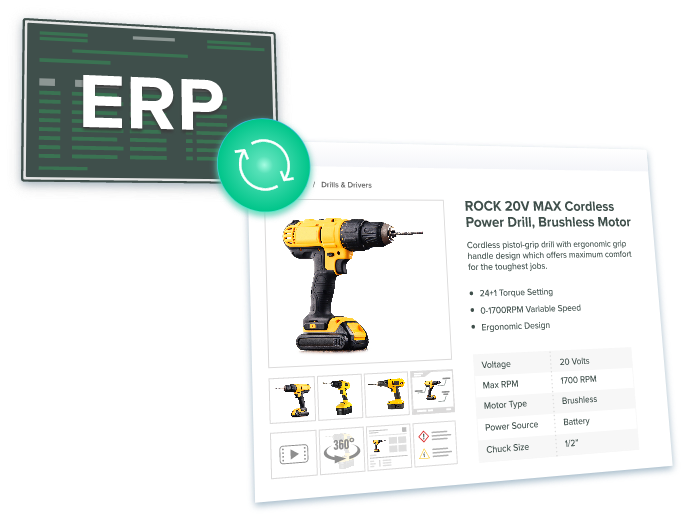
ERP and PIM Integration
Catsy offers a product information management system and enterprise resource planning system integration which eliminates silos and provides a seamless process for fixing and enriching product data. Product content can be aggregated and imported from the ERP into the PIM, where product management can take off with all the tools in Catsy’s PIM and DAM solution.
A continuous sync with the ERP system can be established across all platforms based on a frequency that suits the organization’s needs. This integration enables the free flow of stock-keeping unit information, digital assets, meta-tags, and retail-specific specification templates with just a few clicks.
Using SKUs as the primary identifier, Catsy PIM organizes items while syncing with ERPs and distributors on a timely basis. Other identifiers based on which items need to be organized can be designed and implemented by the brand.
Along with the free flow of SKU data, accurate inventory estimates can be provided to sales teams and partners regularly. After product information and digital assets are enhanced within the Catsy solution, this content can be reverted to the ERP, where existing processes can continue to operate.
Global Data Synchronization Network (GDSN) and PIM Integration
Before product content is sent to the 1WorldSync GDSN data pool, the PIM-DAM system can enrich and optimize information and assets.
This integration eliminates frustrations and saves time across the product’s lifecycle by providing accurate, consistent, and accessible data to suppliers and distributors. Publishing to the GDSN data pool will allow product data to be accessed by marketing teams, thus ensuring the accuracy and consistency of product data on details pages.
Automated workflows
With Catsy customizable workflow tools, tasks can be automated, and roles can be assigned, faster communication is enabled, and increased accountability across the organization. This automated review and approval process enhances productivity by a staggering 60%.
Catsy’s workflows also expedite product updates with accuracy and speed and phase out end-of-life products without sacrificing the loss of company resources. Using these workflows to do all the grunt work, the brand’s internal strategy can be simplified, end-of-life items can be efficiently turned over, and revenue can be increased effectively.
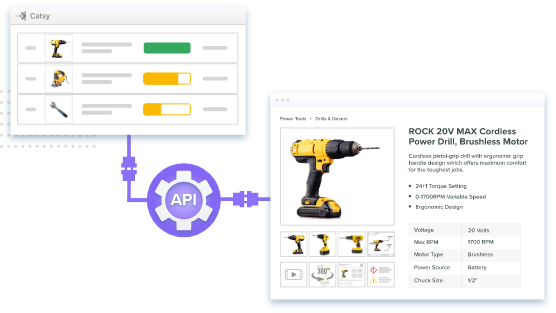
Catsy’s high-limit application programmable interface (API)
Thanks to Catsy’s high-limit API, even the largest catalogs and product profiles can easily be imported, aggregated, validated, enriched, and exported. Large quantities of product content often need to be shared with multiple channels for publishing, which this feature can facilitate.
Conclusion
Launching products faster gives a product more time on the market to drive revenue for your business. Creating many consistent shopping opportunities for your customers also provides more opportunities for conversions.
It’s safe to say that omnichannel eCommerce marketing is one of the most lucrative ways to scale and grow a business in a post-covid marketplace.
As we said, managing multiple channels with multiple products is feasible without a PIM. However, growing the operation to its total capacity while also working product consistency? Oof. That’s burnout waiting to happen. Contact us for a demo. We’d love to show you how PIM/DAM work together to speed your products to market.
PIM & DAM tools provide marketing professionals with a centralized platform to manage and organize product information and digital assets. This streamlines content management processes, making it easier to update and distribute accurate and consistent content across various channels.
PIM & DAM tools ensure brand consistency by serving as a central repository for brand assets such as logos, images, and videos. With these tools, marketers can enforce brand guidelines and ensure that all marketing materials align with the brand’s identity, resulting in consistent customer experiences.
Absolutely. PIM & DAM tools enable marketing professionals to maintain a single source of truth for product information. By centralizing data management and providing robust workflows, these tools help minimize errors and inconsistencies in product descriptions, specifications, and other related content.
PIM & DAM tools facilitate collaboration by allowing marketing teams to work together in a centralized environment. Team members can access, review, and update product information and digital assets, improving communication and efficiency throughout the content creation and publishing processes.
PIM & DAM tools are designed to scale alongside businesses. They offer the ability to handle increasing volumes of product information and digital assets, accommodate larger teams, and integrate with other systems. This scalability ensures that businesses can continue to create consistent customer experiences as they grow and expand their operations.

